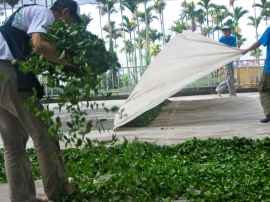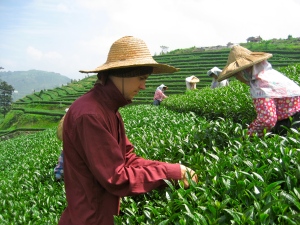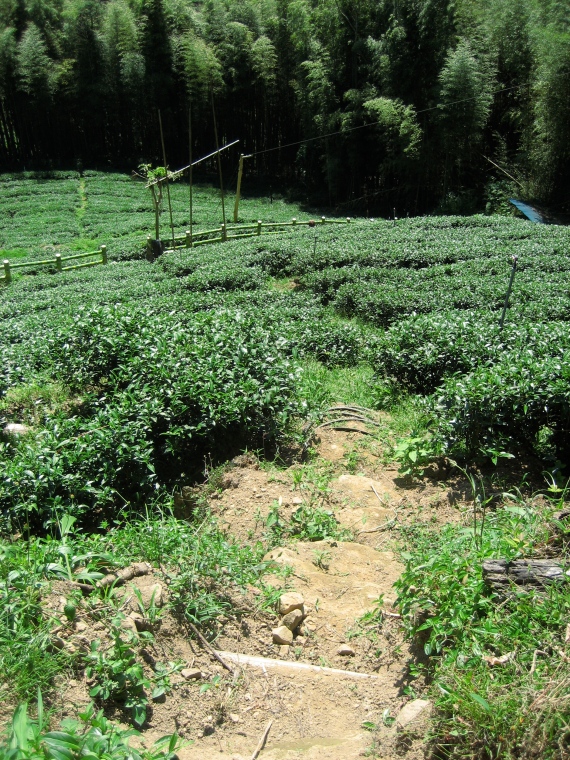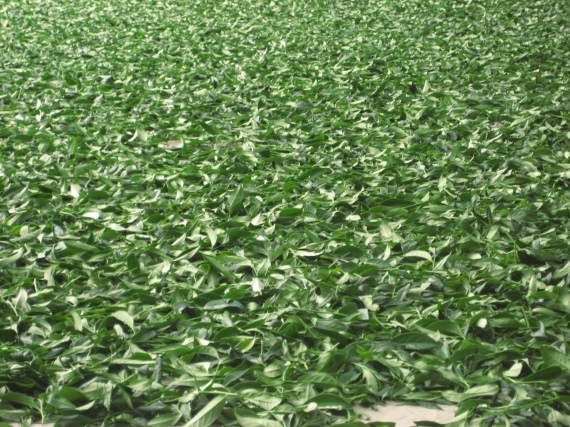Looking back, it all seems like a blur…
I’d like to emphasize the amount of work that goes into making Taiwan Oolong tea, so that we can appreciate why so many hold it in such high regards.
Making tea is a tradition, an art, a craft — and an enduring one at that. I speak not from a journalists’ perspective, but from my own, as someone who took part in the enduring process and marveled at the work carried out by each tea maker. I say “each tea maker” because there are many more than just the ones who own a particular factory. Tea factories are massive and expensive and most tea makers (of which there are many in a tea village) can’t afford one, so they rent the ones already in place. It’s a very interesting relationship between farmers, field workers, and tea makers. One day you’re helping make tea for one tea maker, and the next, he’s helping make tea for you. Sometimes two or three tea makers are using the same facility at the same time! Those are wild days to behold. I should also say that while there are many tea makers (just like there are many cabinet makers, for example) the title of tea master, a title that goes well beyond certification and one I don’t use leisurely, is reserved for the undistinguished few.
 Back to the point! During these intense and sometimes sacred times of harvest, there is a lot of raw material to be processed (into a commercial product). The tea might get to rest during times of withering – but the tea maker doesn’t. One must constantly monitor the weather, the humidity, the look, touch, and smell of the leaf, and know when to change to the next step accordingly. It’s all about withering and knowing when to move on to the next step.
Back to the point! During these intense and sometimes sacred times of harvest, there is a lot of raw material to be processed (into a commercial product). The tea might get to rest during times of withering – but the tea maker doesn’t. One must constantly monitor the weather, the humidity, the look, touch, and smell of the leaf, and know when to change to the next step accordingly. It’s all about withering and knowing when to move on to the next step.
 Withering, both outdoor and indoor, takes all day (about 12 – 15 hours), which requires constant monitoring. Next, tumbling and oxidation might only take a few hours or so. Also keep in mind that hundreds and hundreds of pounds of raw leaf are being handled, so the labor is taxing. There is a lot of running around, spreading of leaves by hand, moving tea-covered tarps indoors, tumbling and re-spreading of leaves, and shuffling of tarps on the withering platform. As you can see, were already at 15 – 18 hours of work in just one day. Depending on the volume of leaf, it’s usually about 1am – 3am at this point and we usually start around 8am. There’s lots more to go and this might go on for up to two weeks straight.
Withering, both outdoor and indoor, takes all day (about 12 – 15 hours), which requires constant monitoring. Next, tumbling and oxidation might only take a few hours or so. Also keep in mind that hundreds and hundreds of pounds of raw leaf are being handled, so the labor is taxing. There is a lot of running around, spreading of leaves by hand, moving tea-covered tarps indoors, tumbling and re-spreading of leaves, and shuffling of tarps on the withering platform. As you can see, were already at 15 – 18 hours of work in just one day. Depending on the volume of leaf, it’s usually about 1am – 3am at this point and we usually start around 8am. There’s lots more to go and this might go on for up to two weeks straight.
At this point (around 2am-ish), the tea is passed on to a night worker, who kills the enzyme halting the oxidative process, and sends the “panned” leaf though a drier. This takes all night/morning and the mid-processed tea lies in heaping piles by about 6am – 7am. The tea maker is up by this time to sample the tea, but more importantly to prepare for withering the next batches of freshly harvested leaves, which come in throughout the morning and afternoon. The mid-processed tea is once again passed on to daytime workers who shape the tea under high pressured rolling machines and lightly heated panning machines. This shaping process, which transforms the tea from a spindly twig-like shape to a compact semi-ball shape, requires about 12 more hours. From here, the tightly rolled tea is stemmed by hand, dried again (and again!) and still has more work to be done, from grading, more stemming, and baking, to sampling, packing, and selling! It’s easily a 40 – 50 hour nonstop process.
While the tea maker isn’t necessarily involved in every step of that two-day process, he is involved in the most crucial steps of each batch: withering and oxidation, and that’s always going to take at least 15 hours for as long as there is tea to be harvested. Considering these tea makers are human, who have basic needs like food, water, sleep, and most of whom have families to care for – this is an enduring tea saga from which they make a livelihood.
And also know that I haven’t even mentioned the work conducted by the field workers, harvesting tea by hand, hour after hour, day after day, in the humid tropical weather of Taiwan. There’s good and practical reasons they wear the apparel they do, and it’s not to look festive and “Asian” for pictures in books. Nor have I included the task of collecting the tea from the pickers and transporting it to the factory — not an easy task. I have personally carried 78 pounds of raw leaf (large in volume) on my back, for about 10 minutes, down a hill-side to the car for transport — twice in one day. Often it’s much easier, but sometimes even harder.
 All physical and mental reserves are exhausted by the end of the harvest, and most tea makers, in an often hilarious and always sleep-deprived state, wonder why the heck they’re doing this. Lying there, next to the bamboo tumbler at 3am, for the fourteenth day in a row, intoxicated on lack of sleep, wondering: why on earth are we doing this — and why is this crazy Canadian here, wearing Taiwan army pants?
All physical and mental reserves are exhausted by the end of the harvest, and most tea makers, in an often hilarious and always sleep-deprived state, wonder why the heck they’re doing this. Lying there, next to the bamboo tumbler at 3am, for the fourteenth day in a row, intoxicated on lack of sleep, wondering: why on earth are we doing this — and why is this crazy Canadian here, wearing Taiwan army pants?
Of course, it doesn’t stop there; there is always cutting back to be done (a huge job considering the sheer size of tea crops), business to conduct, and lots of preparation for the next harvest! Keep in mind that I’m speaking for just one type of Oolong tea, of which there are hundreds and maybe thousands. Oolong tea processing just so happens to be one of the most involved, so other teas definitely require less work.
What I’m also currently learning is that a great deal of effort goes into preparing tea for competitions. For the last week, Mr. Wang has been baking and sampling his tea day after day to come up with just the right look, aroma, and taste to enter into the competition. It’s next Saturday and will my first tea competition!
So if you’re ever wondering why tea “seems” so expensive, consider this blog entry (and the fact that mark-up in Western retail stores is monumental). Tea is actually really cheap considering the amount of work that goes into it. Not to mention it’s made on such a large scale and labour is less expensive here in Taiwan. $50/lb for tea is dirt cheap, depending on the quality, which is always the difficult part I suppose. Don’t compare 1lb of tea to 1lb of coffee; 1lb of tea might last you a year.
So buy good tea and enjoy paying a fair price for it, knowing that regular hard working people are making it under taxing conditions for you to enjoy – and for them to make a living. I will close on this note: buy (and thus vote for) Organic tea. I’ll elaborate more on that in a future post.
TLC















